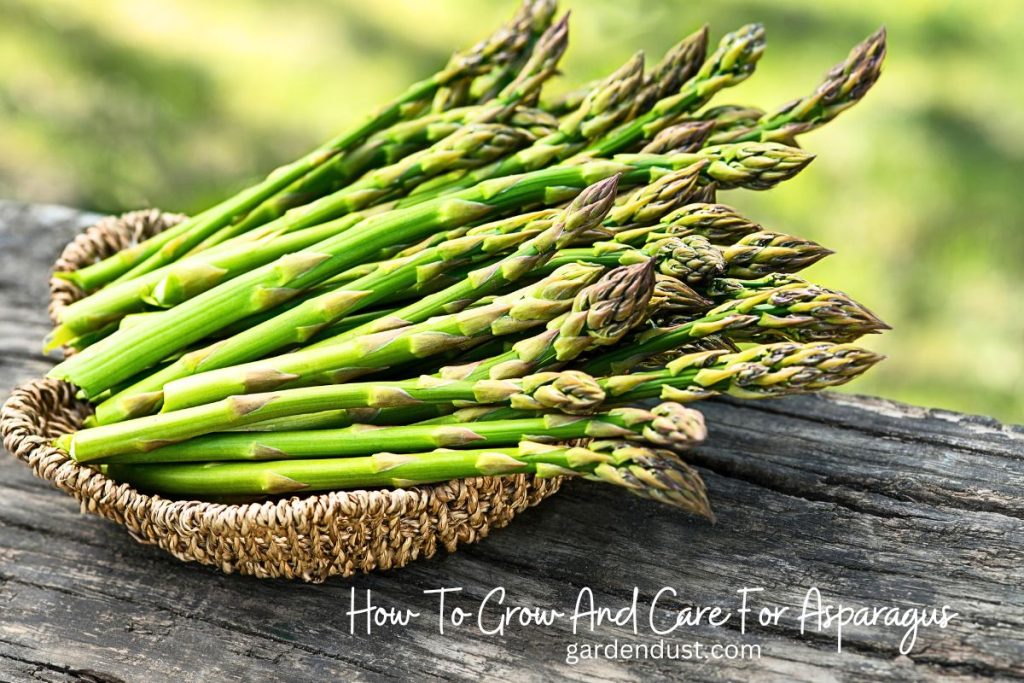Asparagus, with its succulent spears and distinct flavor, is a beloved perennial vegetable that can grace your garden and your plate for decades. Cultivating asparagus requires patience, attention, and a bit of know-how, but the rewards are well worth the effort. In this detailed guide, we’ll take you through every step of the process about How To Grow And Care For Asparagus from preparing the soil to harvesting the delicious spears. Let’s start…
Growing And Caring Guidelines…
Site Selection
Selecting the right location for your asparagus bed is crucial for its long-term success. Choose a sunny spot in your garden that receives at least 6-8 hours of direct sunlight daily. The soil should be well-drained and slightly acidic, with a pH range of 6.5 to 7.5. Avoid areas prone to waterlogging, as asparagus roots are susceptible to rot in soggy conditions.
Soil Preparation
Asparagus thrives in fertile, well-draining soil. Begin soil preparation in the fall before planting. Remove weeds and debris, and incorporate a generous amount of well-rotted compost or aged manure into the soil. This improves soil structure, fertility, and drainage, providing an ideal environment for the asparagus roots to establish.
Planting Asparagus Crowns
Asparagus is usually grown from crowns, which are one-year-old dormant plants. Follow these steps for successful planting:
- Dig a trench about 8-10 inches deep and 12-18 inches wide.
- Space the crowns approximately 12-18 inches apart within the trench.
- Place the crowns at the bottom of the trench, spreading out their roots.
- Cover the crowns with 2-3 inches of soil initially.
Gradual Filling
As the asparagus spears start to grow, gradually fill in the trench with soil until it is level with the surrounding ground. This method protects the emerging spears and prevents crowns from being exposed to the air.
Patience in the First Year
In the first year after planting, refrain from harvesting any spears. Allow them to grow into feathery ferns. This allows the asparagus plant to focus on developing a strong root system.
Second-Year Harvest
In the second year, your patience pays off. You can begin harvesting asparagus spears when they reach around 8-10 inches in height. Snap or cut the spears just above the soil level using a sharp knife. Harvest over a 6-8 week period, but stop when the spear thickness starts to decline.
Fern Growth and Maintenance
After the harvest season, let the remaining spears grow into ferns. These ferns are essential for photosynthesis, which replenishes the plant’s energy reserves. Keep the bed well-watered and free from weeds to support healthy fern growth.
Winter Care
As winter approaches, cut down the ferns to a few inches above the ground. Cover the bed with a layer of mulch to insulate the crowns from freezing temperatures.
Pest and Disease Management
Watch for common pests like asparagus beetles and aphids. Remove any affected foliage and consider using beneficial insects for natural pest control. Fungal diseases can be minimized by ensuring good air circulation and avoiding overhead watering.
READ ALSO:-Amaranth Cultivation: A Comprehensive Guide
Long-Term Maintenance
Asparagus is a long-term investment. Each year, top-dress the bed with compost or well-rotted manure to replenish nutrients. Divide overcrowded crowns every few years to maintain healthy growth.
Propagation
Propagating asparagus can be done through seeds or by dividing established plants. While growing asparagus from seeds is possible, it requires more time and patience compared to using established crowns. Here’s how to propagate asparagus through both methods:
1. Propagation from Seeds:
Asparagus seeds can be sown to grow new plants, but it’s a longer and more intricate process than using crowns.
Steps:
- Seed Collection: Asparagus plants produce red berries containing seeds. Collect ripe berries and extract the seeds. Soak the seeds in warm water for a day to soften the seed coat.
- Seed Stratification: Asparagus seeds require a period of cold stratification to break dormancy. Place the seeds in a damp paper towel inside a plastic bag and refrigerate them for about 2-3 months.
- Sowing: Start the seeds indoors in early spring. Plant them in seed trays or pots filled with well-draining seed-starting mix. Cover the seeds with a thin layer of soil.
- Germination: Keep the soil consistently moist and maintain a temperature around 70°F (21°C). Asparagus seeds can take several weeks to germinate.
- Transplanting: Once the seedlings have grown large enough and outdoor temperatures are suitable, transplant them into the garden. Choose a sunny, well-drained spot.
- Year One: During the first year, allow the seedlings to grow without harvesting any spears. This helps them establish strong root systems.
- Year Two: In the second year, you can start harvesting spears sparingly.
2. Propagation by Division:
Dividing established asparagus plants is a more common and faster way to propagate.
Steps:
- Established Plants: Choose well-established asparagus plants that are at least three years old.
- Dormant Season: Perform division during the plant’s dormant season, either in late fall after the foliage has died back or in early spring before new growth starts.
- Lifting the Plant: Gently dig up the asparagus plant, taking care not to damage the roots.
- Dividing: Divide the plant into sections, making sure each section has healthy roots and buds (crowns). Use a sharp, clean knife to cut through the root system.
- Trimming: Trim the foliage and roots of each divided section. Leave about 6-8 inches of the fern-like growth.
- Replanting: Plant the divided sections in prepared soil, following the same planting depth and spacing guidelines as with crowns.
- Care: Water the newly planted divisions thoroughly and continue with regular care as you would for established plants.
Health Benefits Of Asparagus
Asparagus is not only a delicious and versatile vegetable, but it also offers a range of health benefits due to its rich nutritional profile. Incorporating asparagus into your diet can contribute to your overall well-being. Here are some of the notable health benefits of asparagus:
Nutrient-Rich:
Asparagus is a low-calorie vegetable that’s packed with essential nutrients. It’s a good source of vitamins and minerals, including vitamin K, vitamin C, vitamin A, vitamin E, and folate. These nutrients play important roles in maintaining overall health and supporting various bodily functions.
Fiber Content:
Asparagus is a good source of dietary fiber, both soluble and insoluble. Fiber supports healthy digestion, prevents constipation, and may contribute to weight management by promoting a feeling of fullness.
Antioxidant Properties:
Asparagus contains various antioxidants, including vitamins A and C, as well as phytonutrients like flavonoids and polyphenols. These antioxidants help protect cells from oxidative stress, reduce inflammation, and contribute to the prevention of chronic diseases.
READ ALSO:-Health Benefits Of Curry Leaves
Digestive Health:
The fiber content in asparagus supports a healthy digestive system. It can aid in promoting regular bowel movements, preventing constipation, and maintaining a healthy gut environment.
Heart Health:
Asparagus contains compounds like folate and B vitamins that are important for cardiovascular health. Folate helps regulate homocysteine levels in the blood, which can reduce the risk of heart disease. The fiber and antioxidants in asparagus also contribute to heart health by promoting healthy cholesterol levels and reducing inflammation.
Blood Sugar Regulation:
Asparagus has a low glycemic index and contains antioxidants that may help improve insulin sensitivity. Including asparagus in your diet can contribute to better blood sugar control, making it a suitable option for individuals with diabetes or those looking to prevent blood sugar spikes.
Bone Health:
Asparagus contains vitamin K, which is important for bone health as it contributes to proper calcium absorption and bone mineralization. Adequate vitamin K intake is associated with a reduced risk of fractures and improved bone density.
Diuretic Effect:
Asparagus has natural diuretic properties due to the presence of an amino acid called asparagine. This can aid in flushing out excess salt and fluids from the body, potentially benefiting individuals with high blood pressure or water retention.
Brain Health:
The presence of folate in asparagus is not only beneficial for cardiovascular health but also for brain health. Folate plays a role in neurotransmitter synthesis and may contribute to cognitive function.
Weight Management:
Asparagus is low in calories and rich in fiber, making it a satisfying addition to meals. Including asparagus in your diet can help you feel full for longer periods, which can support weight management efforts.
Incorporating asparagus into a well-balanced diet can contribute to these health benefits. Whether enjoyed in salads, soups, stir-fries, or as a side dish, asparagus is a nutritious addition that can enhance both the flavor and nutritional value of your meals.
Final Thoughts
Growing and caring for asparagus is a journey that requires dedication and patience. From selecting the right site to nurturing the plants through their various growth stages, each step contributes to a bountiful and delicious harvest. As you follow these detailed guidelines, remember that your efforts will be rewarded not only with a bumper crop of delectable spears but also with the satisfaction of mastering the art of cultivating asparagus. Happy Gardening…






